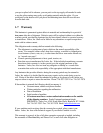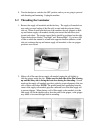1-5 Principles of Operation
The laminator operates by pulling film with a thermally activated adhesive over a heat
source and into a set of laminating rollers. Film from a supply roll passes over heat shoes
to activate a polyethylene adhesive layer on the film. It then passes through rubber
rollers to apply pressure and bond the film to the item being laminated. The film’s
adhesive is pressed into the ink and fibers on the surface of the paper.
The strength of the lamination bond can be checked by cutting a large “X” on the surface
of a laminated sample with a sharp blade. Use the tip of the blade to pry up one corner of
the “X”. Grab that corner and pull up the film. Ink and/or paper fibers coming up with
the layer of film indicates a good adhesive bond.
If the film comes up too easily, with no ink or paper, the lamination was probably done at
too low a temperature. Check the instructions that may have come with your laminating
film and/or the lamination chart in section 5-5.
Please note that when doing X-test on glossy (coated) paper, a good X-test will pull up
ink only. The film should not come up easily. When laminating material that is not
glossy (uncoated), the paper is often more fibrous and a good X-test will yield ink and
paper fibers coming up with the film.
1-6 Laminating Film
Most thermal laminating film consists of two layers: a base of polyester and an adhesive
layer of polyethylene. The polyester layer forms the harder outer surface of the film and
does not melt at laminating temperature. It provides rigidity and protection for your
laminated items. The greater the polyester content, the higher the level of protection,
rigidity and luster. The polyethylene layer melts at laminating temperature and bonds the
film onto the subject material under the pressure of the laminating rollers. As an X-test
demonstrates, the adhesive is pressed into the paper and fills irregularities in the surface.
The proportion of polyester and polyethylene in a film is usually described with numbers.
For example a “1-2” film consists of one mil of polyester and two mils of polyethylene.
The first number refers to the base layer. The second number refers to the adhesive layer.
A mil is 1/1000 of an inch.
Since polyester is the more costly of the two types of plastic generally used in laminating
film, a “3-2” film will cost more than a “2-3” film. Both are 5–mil films but the “3-2”
version will seem a little thicker on a piece of laminated material because it will be
slightly stiffer. Thermal laminating films are available in many different base/adhesive
combinations. Five-mil film, for example 1-4, 2-3, 3-2, and 4-1 combinations.
In the US laminating trade, the generally accepted practice is to describe two-sided
lamination, or encapsulation, by the thickness of one layer of film. For example, “3-mil


















